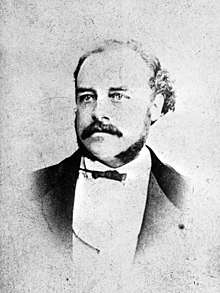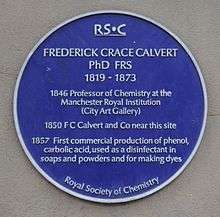Frederick Crace Calvert
Frederick Crace Calvert (November 14, 1819 – October 24, 1873), English chemist, was born near London[1]. He was the son of Alfred Crace and the nephew of the noted interior decorator, Frederick Crace.

From about 1836 until 1846 he lived in France, where, after a course of study at Paris, he became manager of some chemical works, later acting as assistant to Michel Eugène Chevreul. On his return to England he settled in Manchester as a consulting chemist, and was appointed honorary professor of chemistry at the Royal Manchester Institution. Devoting himself almost entirely to industrial chemistry, he gave much attention to the manufacture of coal-tar products, and particularly carbolic acid (for use in the treatment of raw sewage), for the production of which he established large works in Manchester in 1865. Besides contributing extensively to the English and French scientific journals, he published a work on Dyeing and Calico-Printing. He died in Manchester.[2]
He is commemorated by a Royal Society of Chemistry blue plaque on Princess Street in Manchester.[3]
References
![]()
- Dyeing and calico printing : including an account of the most recent improvements in the manufacture and use of aniline colours : illustrated with wood engravings and numerous specimens of printed and dyed fabrics https://archive.org/details/gri_c00033125001045000
- Chemical News, Dec 12 p300, 1873, Feb 5 p56-57, 1875, Dec 24 p300-301, 1875.
- Plaque #40041 on Open Plaques, Retrieved 8 August 2015.
